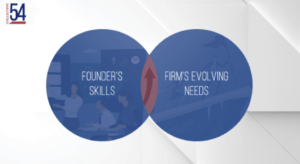Knowing When to Leave: The Founder’s Role in a Professional Service Firm

The early launch days of a professional service firm are often characterized by the visionary leadership of its founder. The founder’s dedication, expertise, and passion are instrumental in establishing the firm and shaping its culture. However, there comes a time when the founder must evaluate whether it is appropriate to continue in their current role or hand over management responsibility to a CEO. This decision can be challenging, as it involves considering what is lost when a founder leaves versus what is gained from new leadership.
During the early days, the founder plays a pivotal role in setting the direction, building relationships, and establishing the firm’s reputation. They possess deep industry knowledge and are often the driving force behind the firm’s initial success. The founder’s commitment and personal touch are instrumental in attracting clients, fostering a cohesive team, and navigating the challenges of starting a business.
However, as the firm grows, the demands and complexities increase exponentially. Scaling a professional service firm requires a different set of skills, including operational expertise, strategic vision, and leadership acumen. Recognizing these evolving needs is crucial in determining the right time for the founder to transition to a different role or bring in a CEO.
Several indicators can help assess if the founder should consider a change. One common sign is the adoption of “flavor of the week” strategies that cause employee whiplash. If the firm frequently changes its direction without a clear long-term vision, it can lead to confusion, disengagement, and reduced productivity among employees. Similarly, high turnover in the C-suite, growth stagnation at a certain size, excessive internal politics, and the founder becoming a bottleneck for decision-making are all signs that a founder may have overstayed their role.
When a founder leaves, there are various impacts on the firm. One of the immediate consequences is the morale issues that loyal employees may experience. The founder’s departure can create a sense of uncertainty and loss, especially if they were deeply involved in day-to-day operations. It becomes crucial for the new CEO or leadership team to step in and provide reassurance, transparency, and stability during this transition period.
The departure of a founder also necessitates a period of shakeout in the management team. With new leadership, there may be adjustments in roles and responsibilities, potentially resulting in some executives leaving or being replaced. This phase requires careful communication, clear expectations, and support for the team members who remain.
Maintaining positive relationships with clients is another vital aspect following a founder’s departure. Clients often develop strong ties with the founder, and it is crucial to reassure them that the firm’s values, quality, and commitment to excellence will continue under new leadership. Open and honest communication is key to retaining clients and ensuring a smooth transition.
In some cases, it may be possible for the founder to remain within the firm but in a different role. This arrangement allows the founder to continue contributing their expertise and industry knowledge while relieving them of operational and management responsibilities. However, the likelihood of a founder agreeing to such a new structure depends on individual circumstances, personal aspirations, and the founder’s ability to adapt to a different role within the organization.
Research studies have shed light on the percentage of founders who successfully make it to the exit. According to a reputable source, a study conducted by Harvard Business School found that only around 25% of founders are still at the helm when a professional service firm reaches the exit point. This statistic highlights the common occurrence of founders transitioning out of their leadership roles as firms evolve and grow.
Here is a specific tool designed exclusively for founders of professional service firms to assess if they have stayed at their firm too long. It is a SWOT analysis, which stands for Strengths, Weaknesses, Opportunities, and Threats. It has been adapted to help founders evaluate their position within the firm. Here’s how you can apply it:
-
- Strengths: Assess your personal strengths and skills as a founder. Are your core competencies aligned with the current needs and strategic direction of the firm? Evaluate if your expertise and leadership style are still relevant and effective in the evolving business landscape.
- Weaknesses: Reflect on your limitations and areas where you may have become a bottleneck or hindered the firm’s growth. Consider if there are aspects of the business that would benefit from new perspectives or different skill sets. Assess whether your weaknesses are impeding the firm’s progress and if they can be addressed through training, delegation, or restructuring.
- Opportunities: Identify opportunities for growth, innovation, and expansion that may require new leadership or different expertise. Consider emerging trends, market shifts, and evolving client needs. Assess if promoting someone to CEO or transitioning to a different role would enable the firm to seize these opportunities more effectively.
- Threats: Evaluate potential threats and challenges that could impact the firm’s long-term success. Assess if your continued involvement as the founder poses any risks, such as limited scalability, difficulty in attracting and retaining top talent, or being resistant to change. Consider whether new leadership would mitigate these threats and position the firm for sustained growth.
Additionally, seeking feedback from peers from a mastermind community, such as Collective 54, can provide valuable insights into your role and impact within the firm. Their perspectives can help you gain a more objective understanding of whether you have overstayed your position and if it’s time for a transition.
Remember, self-assessment tools are meant to guide your reflection and decision-making process, but ultimately the choice to stay or leave rests on your personal circumstances, aspirations, and the best interests of the firm.
